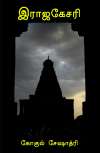Rajakesari
Rajakesari (Tamil:இராஜகேசரி), meaning "a lion among Kings" [1] is a Tamil language historical novel written by Gokul Seshadri. Though it is a work of fiction, it is based on extensive historic research and delves deep into various socio-cultural aspects of ancient Tamil Nadu. Rajakesari was followed by Cherar Kottai in 2012 by the same author.
 | |
| Author | Gokul Seshadri |
|---|---|
| Original title | Rajakesari |
| Illustrator | Gokul Seshadri |
| Country | India |
| Language | Tamil |
| Series | Rajakesari |
| Genre | Tamil historical novels |
| Publisher | Palaniappa Brothers |
Publication date | Jan 2008 |
Published in English | No |
| Media type | Book |
| Pages | 360 |
| ISBN | 9788183795050 |
| Followed by | Cherar Kottai |
Plot summary
The year is 1003 AD. The capital is abuzz with birthday celebrations of the Chola emperor Rajaraja Chola, whose natal star Satabhisak (Sadayam) falls in the month of Asvina (Aippasi).[2] People from all walks of life are gathering themselves to celebrate the event in all pomp and glory.
In city’s suburbs, Rajarajeswarm (present day Brahadishwara Temple), a massive temple complex of epic proportions, personally commissioned by the king about a year ago, is taking shape.[3] Massive blocks of granite are getting unloaded from large elephant carts. Adittan Suriyan, the chief accounting officer of the project,[4] is busy overseeing various aspects of temple building activity. The campus is bustling with people from all walks of life like sculptors (Sthapathis), painters (Chaitrikas), engineers (Vasthu experts), religious pundits and Saivite gurus. A select band of 400 dancing girls (Thevaradiyar, which means Servants of God),[5] chosen from numerous temples located across the empire, have been called upon to attend to the services of Lord Raajarajeswara.
Intent to impress upon the emperor and the state, a seasoned dance drama troupe, headed by a veteran by name Vijayaraja Acharya, whose family belongs to a prestigious school of Artists - is busy doing the final rehearsals of their brand new dance drama titled "Rajaraja Vijayam" (the visit of Rajaraja).[6] The theme of this drama is purportedly inspired by the life of the emperor himself.
While the Chola heartland is thus immersed in merriment and joy, several hundred miles away, deep within the jungles of Chera country (Kerala), a sinister plot has been hatched. The envoys of these forces are already in the city, awaiting opportunity to strike a deadly final blow.
Meanwhile, the life of an innocent countryside man from a remote Chola village is shaken by a murder that happens right in front of his eyes. This old man of 55 years, forcefully retired from the Chola army after a fatal injury, is pulled into the dangerous game of political treachery. Armed with a sense of getting justice, this physically challenged soldier undertakes an epic journey into the Chola capital that puts him in direct confrontation with the dark forces. Rajakesari is the story of this unlikely hero and his three day adventure at the capital.
Characters
- Rajaraja Chola(Historical)
- Rajaraja Marayar(Historical)
- Ambalavanar (Fictional)
- Paraman Malapadiyar(Historical)
- Arikanda Devan (Fictional)
- Amangudi Krishnan Raman (Historical)
Publication history
The story was originally serialized in Varalaaru.com a monthly web magazine from 2004 onwards. It was later published as a book by Palaniappa Brothers in 2008.
Book reviews
References
- Chola kings of South India bore the titles Rajakesari and Parakesari, alternatively.K.A.Nilakanda Sastri, The Colas, Madras University.
- Several epigraphical references point to the fact that Rajaraja's birthday was celebrated during his times. The earliest such reference is provided by the Muttam Record of Rajaraja. South Indian Inscriptions-Vol 3.
- From the available inscriptions, it is surmised that Rajaraja commissioned the Big temple project sometime at around 1002 AD.South Indian Inscriptions-Vol 2 and Sivapadhasekaranin Thanjai Kalvettukkal, Ed.R.Nagasamy.
- Thanjavur temple inscriptions talk of this officer and his donations, which included bronze statues of Saivite Nayanmars. South Indian Inscriptions-Vol 2
- A lengthy inscription from Thanjavur temple records the names of all these girls, the temples they came from and the door number of houses allocated to them. Thalicheri Kalvettu.R.Kalaikkovan
- An inscription from Tiruppunturutti refers to this drama written by Suvarnan Naranan Battaradittan.T.V.Sadasiva Pandarathar, Pirkala Chozhar Varalaaru, Annamalai University Publications.